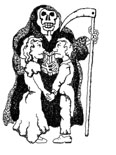
The Fruit of Contraception
GUEST COLUMNS
Races have been run, ribbons have been worn, and the multimillion-dollar business of breast cancer closed yet another successful October awareness month. While grocery and department stores stocked counters with anything pink, hoping to cash in on the breast-cancer craze, the Mayo Clinic quietly released a study. No hype, no fanfare, and absolutely no media coverage. Perhaps because the study reiterated the link between oral contraceptives and breast cancer. The research concluded that the risk for breast cancer is increased by 44 percent for women who take the Pill before conceiving their first child. It is such a significant risk that the main author of the investigation stated that women must be informed of it. In 2005 the International Agency for Research on Cancer classified the Pill as a “group one carcinogen,” placing it in the company of such other deadly chemicals as mustard gas, asbestos, arsenic, and neutron radiation.
Instead of applauding the Mayo Clinic study, the Susan G. Komen Breast Cancer Foundation, a well-known promoter of the “Race for the Cure” marathon, handed Pill-pusher Planned Parenthood a check for $25,000. It is remarkable that many of the same women who buy organic products and care deeply about the environment are eager to fill their bodies with cancer-causing contraceptives. It seems this race will never find a cure.
One cannot miss the ads for artificial birth control that are plastered throughout the print media. Usually a woman is pictured skipping through fields of flowers or jumping in the air as if she has not a care in the world. Of course, these advertisements are trying to suggest that birth control equals “freedom.” But I was dumbfounded to see in my latest issue of Better Homes and Gardens, nestled among the holiday recipes, room makeover ideas, and stealthily hidden in the “Healthy Family” section, an article titled “Over 40 Birth Control.” With trendy names such as YAZ and Seasonique, the reader is given an overview of the varying forms of contraception available. The article features a picture of a woman lying with her significant other in perfect, marital (or non-marital, I suppose) bliss. She must be so happy, the reader should conclude. I wonder what birth control she uses, one might ask, maybe the IUD? If so, this special lady has a device inserted in her uterus that releases copper into her body. Fun! Perhaps she uses the Implanon. If she does, then match-size plastic rods are inserted into her arm. Lucky girl! But maybe she is using the NuvaRing. If so, a plastic ring is placed into her vagina each month. Neat! Or maybe it’s the Pill, a popular choice for most women, which, according to the article “reduces [a woman’s] risk of ovarian cancer by 80%.” Great! But no mention of breast cancer. Am I missing something?
You May Also Enjoy
Cardinal Burke, the Church's foremost expert on annulment, said the process is "essentially connected with the doctrinal truth" of the Church, and changes should be considered with great care.
Men and women today are tired of unfaithfulness, tired of shallow and brief relationships. They crave something more meaningful and reliable.
A couple I know chose not to have children — more her active choice and his acquiescence. As mid-life approached they realized their marriage was dry, sterile.

